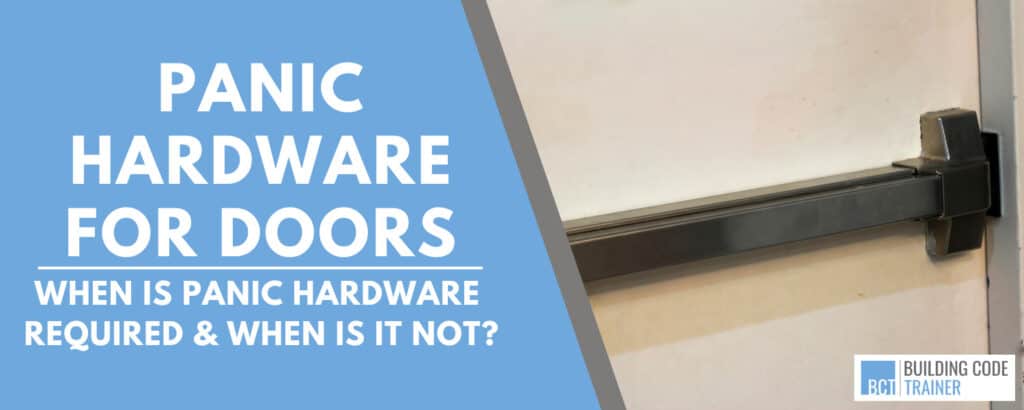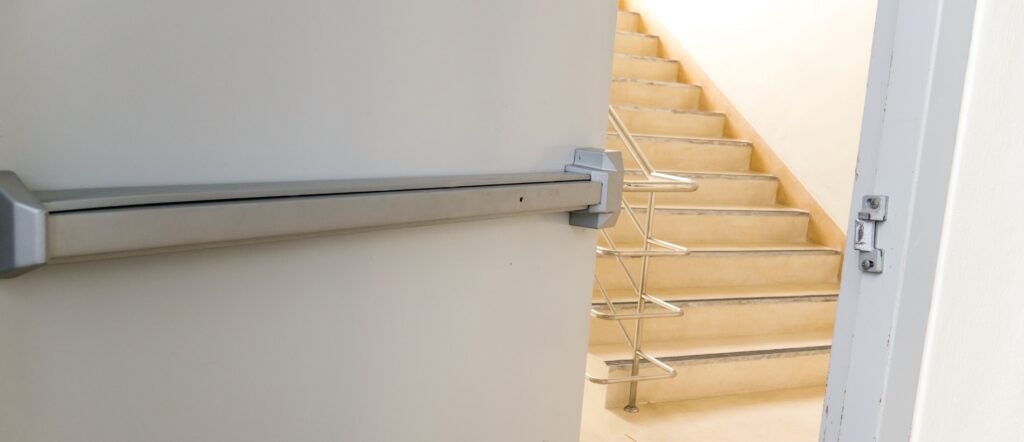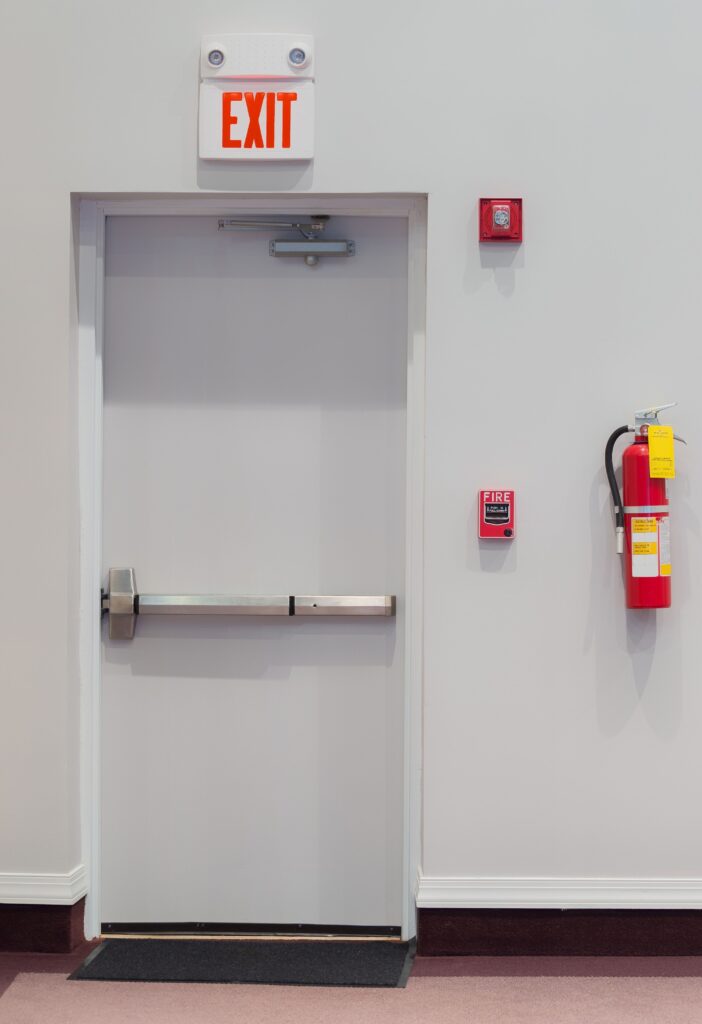Author : Building Code Trainer

In order to determine if a door requires panic hardware, we will be looking at Section 1010 of the 2021 International Building Code (IBC) which outlines when panic hardware is required.
This section deals with doors that serve as a means of egress system. When you go through this section you will eventually come to Section 1010.2.9 labeled “Panic and Fire Exit Hardware”.
It is here in this section that outlines when they are required based on certain triggers. Lets take a look to see what these triggers are.
When is Panic Hardware for Doors Required?
Section 1010.2.9 of the 2021 International Building Code reads as follows:
Panic and fire exit hardware. Swinging doors serving a Group H occupancy and swinging doors serving rooms or spaces with an occupant load of 50 or more in a Group A or E occupancy shall not be provided with a latch or lock other than panic hardware or fire exit hardware.
Group A, E, & H Occupancies
Based on this code section you can see that a swinging egress door serving all Group H occupancies requires panic hardware.
Also a swinging egress door serving a space with an occupant load of 50 or more within a Group A or E occupancy requires panic hardware.
It is important to note that this is for egress doors which would typically have latching or locking hardware installed. If the above scenarios are triggered, the door hardware must be panic hardware.
Refrigeration Machinery Rooms
Is panic hardware required in refrigeration machinery rooms?
Another location that would require panic hardware is in refrigeration machinery rooms. If you continue reading, Section 1010.2.9.1, you will find the following code language:
Refrigeration machinery rooms larger than 1,000 square feet shall have not less than two exit or exit access doorways that swing in the direction of egress travel and shall be equipped with panic hardware or fire exit hardware.
Based on this section you can see that refrigeration machinery rooms larger than 1,000 square feet require panic hardware on no less than two exits that swing in the direction of egress travel.
Electrical Rooms
Is panic hardware required in electrical rooms?
Another location that would require panic hardware is in electrical rooms. If you continue reading, Section 1010.2.9.2, you will find the following code language:
Exit or exit access doors serving transformer vaults, rooms designated for batteries or energy storage systems, or modular data centers shall be equipped with panic hardware or fire exit hardware. Rooms containing electrical equipment rated 800 amperes or more that contain overcurrent devices, switching devices or control devices and where the exit or exit access door is less than 25 feet from the equipment working space as required by NFPA 70, such doors shall not be provided with a latch or lock other than panic hardware or fire exit hardware. The doors shall swing in the direction of egress travel.
Based on this code language you can see that certain types of electrical rooms would require panic hardware. When multiple conditions are present a potentially hazardous environment is created and thus a more immediate way of egressing, such as panic hardware, is required.
For more specific requirements of panic hardware serving electrical rooms, you can refer to NFPA 70.
What is Panic Hardware?

The code says to install panic hardware or fire exit hardware, but what are they and what’s the difference?
What is the difference between Panic Hardware and Fire Exit Hardware?
Well in order to understand this, we need to look are these definitions in Chapter 2 of the IBC. The definitions in chapter 2 read as follows:
Panic Hardware vs Fire Exit Hardware
PANIC HARDWARE. A door-latching assembly incorporating a device that releases the latch upon the application of a force in the direction of egress travel. See “Fire exit hardware.”
FIRE EXIT HARDWARE. Panic hardware that is listed for use on fire door assemblies.
Based on the first definition you can see that panic hardware is a type of device that releases the latch mechanism on a door upon applying force to the hardware in the direction of travel.
This is necessary so that the door can easily open during an emergency whereas typical non-panic type hardware might nor operate when a large amount pressure is applied to the door from multiple people rushing through it during an emergency.
As for fire exit hardware, it is essentially panic hardware that has been tested and listed for use on fire rated doors serving as a means of egress. When a fire rated door is required to have panic hardware installed, the hardware is required to be listed for use on a fire door, thus labeling it as “Fire Exit Hardware”.
This type of “panic hardware” has been tested to function properly when is is exposed to the effects of a fire.
Exceptions for Panic Hardware

Are there any exceptions to not installing panic hardware?
Two Exceptions
Section 1010.1.10 lists two. The code section reads a follows:
1. A main exit of a Group A occupancy shall be permitted to have locking devices in accordance with Section 1010.2.4, Item 3.
2. Doors provided with panic hardware or fire exit hardware and serving a Group A or E occupancy shall be permitted to be electrically locked in accordance with Section 1010.2.11 or 1010.2.12.
3. Exit access doors serving occupied exterior areas shall be permitted to be locked in accordance with Section 1010.2.4, Item 8.
4. Courtrooms shall be permitted to be locked in accordance with Section 1010.2.13, Item 3.
Exception 1 adds a provision that key-operated locking hardware used on main exit doors in a Group A occupancy are allowed instead of panic hardware when complying with Section 1010.2.4 Item 2.
Exception 2 is added to potentially resolve a conflict between Section 1010.2.11 and Section 1010.2.12.
Exception 3 applies to outdoor areas where an occupant has to egress through the building as part of the means of egress system. If specific requirements are met, a key operated lock can be installed instead of panic hardware if all the items in Section 1010.2.4 Item 8 are met.
Exception 4 is for courtrooms. If Section 1010.2.13 Item 3 is met, some doors in the courtroom would be allowed to use delayed egress locks.
These are the only four exceptions listed for panic and fire exit hardware.
How much does panic hardware cost?
Depending on the type of panic hardware you buy, prices can range from $100 to $500. If panic hardware has to be consider fire exit hardware, as previously discussed above, this cost can increase significantly.
For an idea of how much panic hardware can cost, be sure to check out the Amazon link below.
- Excellent quality and a great value. The Dynasty Hardware panic bar exit device has passed testing of over half a million cycles and is grade 1 certified. This panic device with exterior lever is ADA approved for medium to high traffic doors.
- This panic device is reversible so it can be installed on right or left hand doors. This set includes an exterior lever that can be locked or unlocked using the provided keys. This panic device uses a SC1 keyway.
- Each set includes a dogging feature and includes the dogging hex key. . Dogging a device holds the latchbolt retracted removing the need to turn the lever or push the panic bar to retract the latch and open the door. You essentially only have to push or pull the door for it to open when the exit hardware is “dogged” This is perfect for high traffic doors.
- Product's actual size: 31 inches, Fits Doors 30" through 36" Wide - Can be cut to size. Perfect for either wood or metal doors. Not intended for use on glass storefront doors.
- Limited - Lifetime Factory Warranty
Final Words
Panic hardware is an important feature to ensure occupants can safely exit a space. Having proper understanding of when and where to install panic hardware is of utmost importance to any code professional.
For more information regarding panic hardware requirements, be sure to check out Section 1010.2.9 of the 2021 International Building Code.
Related Articles to Read:
- How to Calculate Occupant Load | Easily Explained with Examples
- Corridor Fire Rating Requirements | Explained!
- Commercial Stair Codes: EXPLAINED
About the Author

Building Code Trainer
AuthorThis site is run and maintained by a Certified Building Official, Plans Examiner, and Inspector. With a Bachelors of Science Degree in Construction Engineering along with holding multiple ICC certifications, the Author of this site has over 15 years of experience within the construction industry.

